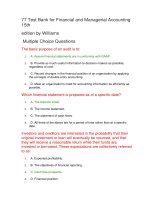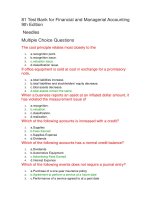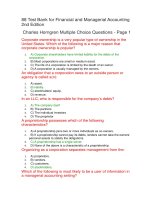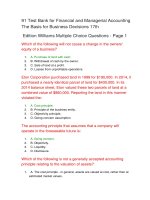Test bank for financial and managerial accounting 3rd edition
Bạn đang xem bản rút gọn của tài liệu. Xem và tải ngay bản đầy đủ của tài liệu tại đây (287.9 KB, 55 trang )
Test Bank for Financial and Managerial Accounting 3rd
Edition
Ace Machine Co. had the following transactions in June: Earned $4,000 "on
account;" collected $3,000 from a customer which was owed from a previous
month; incurred $500 of repair expense and paid cash to the repairman; paid
$1,200 to a supplier that it owed from the previous month; paid out $800 in
cash dividends to shareholders. What is the combined effect on Retained
earnings of the June transactions?
1. A) Down $2,700
2. B) Down $5,700
3. C) Up $2,700
4. D) Down $4,500
Ace Machine Co. had the following transactions in June: Earned $4,000 "on
account;" collected $3,000 from a customer which was owed from a previous
month; incurred $500 of repair expense and paid cash to the repairman; paid
$1,200 to a supplier that it owed from the previous month; paid out $800 in
cash dividends to shareholders. What is the combined effect on Cash of the
June transactions?
1. A) Up $500
2. B) Down $5,700
3. C) Down $2,700
4. D) Up $4,500
Ace Machine Co. had the following transactions in June: Earned $4,000 "on
account;" collected $3,000 from a customer which was owed from a previous
month; incurred $500 of repair expense and paid cash to the repairman; paid
$1,200 to a supplier that it owed from the previous month; paid out $800 in
cash dividends to shareholders. How much was the Net income in June?
1. A) $500
2. B) $5,700
3. C) $2,700
4. D) $3,500
ABC Delivery Co. had the following transactions in June: Earned $4,000 cash
for services rendered; collected $2,500 from a customer "on account;" paid
out $200 cash for plumbing services; received $3,500 of supplies and
promised to pay one month later; paid out $1,000 in cash dividends to
shareholders. What is the combined effect on Retained earnings of the June
transactions?
1. A) Up $2,800
2. B) Down $300
3. C) Down $6,300
4. D) Up $5,300
ABC Delivery Co. had the following transactions in June: Earned $4,000 cash
for services rendered; collected $2,500 from a customer "on account;" paid
out $200 cash for plumbing services; received $3,500 of supplies and
promised to pay one month later; paid out $1,000 in cash dividends to
shareholders. What is the combined effect on Cash of the June
transactions?
1. A) Up $1,800
2. B) Down $300
3. C) Down $6,300
4. D) Up $5,300
ABC Delivery Co. had the following transactions in June: Earned $4,000 cash
for services rendered; collected $2,500 from a customer "on account;" paid
out $200 cash for plumbing services; received $3,500 of supplies and
promised to pay one month later; paid out $1,000 in cash dividends to
shareholders. How much was Net income in June?
1. A) $5,300
2. B) $2,800
3. C) $6,300
4. D) $3,800
Beginning retained earnings was $25,000. Ending retained earnings is
$37,000. Dividends paid were $23,000. What was net income or loss for the
year?
1. A) Net income of $16,000
2. B) Net loss of $35,000
3. C) Net loss of $14,000
4. D) Net income of $35,000
Net income is $34,000. Beginning retained earnings is $29,000. Ending
retained earnings is $55,000. What was the amount of dividends paid?
1. A) $18,000
2. B) $8,000
3. C) $60,000
4. D) $5,000
Beginning retained earnings is $20,000. Dividends paid were $7,000. Ending
retained earnings is $37,000. What was net income?
1. A) $24,000
2. B) $13,000
3. C) $10,000
4. D) $27,000
Financial statements are prepared after an entity's transactions are analyzed
and recorded. Which of the following reports is NOT one of the required
financial statements?
1. A) Statement of cash flows
2. B) Balance sheet
3. C) Statement of dividends paid
4. D) Income statement
The statement of retained earnings shows the changes in retained earnings.
Which one of these statements is TRUE?
1. A) Increases in Retained earnings result from owner investments.
2. B) Decreases in Retained earnings result from net losses.
3. C) Increases in Retained earnings result from net losses.
4. D) Decreases in Retained earnings result from revenues earned.
The income statement presents a summary of an entity's revenues and
expenses for a period of time. Which of the following statements is
TRUE?
1. A) There is net income when total revenues are greater than total expenses.
2. B) There is a net loss when total expenses are greater than total revenue.
3. C) There is a net loss when dividends are paid.
4. D) Both A and B are true.
The balance sheet, or statement of financial position, is like a snapshot of the
entity. Which of the following items are included on the balance sheet?
1. A) Revenues
2. B) Expenses
3. C) Assets
4. D) Dividends paid
Each financial statement includes a heading giving three pieces of data.
Which of the following items is NOT included in these headings?
1. A) Name of the financial statement
2. B) Date or time period covered
3. C) Name of the preparer of the statement
4. D) Name of the business
Which of the following financial statements reports expenses in decreasing
order of their amount, with the largest expense first?
1. A) Statement of cash flows
2. B) Income statement
3. C) Statement of retained earnings
4. D) Balance sheet
Which of the following financial statements uses net income or net loss taken
directly from the income statement?
1. A) Statement of retained earnings
2. B) Statement of cash flow
3. C) Balance sheet
4. D) Statement of dividends paid
Which of the following financial statements reports that total assets equals
total liabilities plus total stockholders' equity?
1. A) Statement of retained earnings
2. B) Statement of cash flows
3. C) Income statement.
4. D) Balance sheet
Which of the following financial statements reports cash receipts and cash
payments during a period of time?
1. A) Statement of cash flows
2. B) Balance sheet
3. C) Income statement
4. D) Statement of retained earnings
Which of the following financial statements reports an increase or decrease in
net cash during the time period covered?
1. A) Income statement
2. B) Statement of retained earnings
3. C) Statement of cash flows
4. D) Balance sheet
The financial statements should be prepared in what order?
1. A) Income statement, statement of retained earnings, balance sheet,
statement of cash flows
2. B) Statement of retained earnings, balance sheet, income statement,
statement of cash flows
3. C) Balance sheet, statement of retained earnings, income statement,
statement of cash flows
4. D) Balance sheet, income statement, statement of retained earnings,
statement of cash flows
Which of the following amounts appear on both the income statement and the
statement of retained earnings?
1. A) Ending retained earnings
2. B) Total revenues
3. C) Net income
4. D) Dividends paid
Which of the following amounts appears on both the statement of retained
earnings and the balance sheet?
1. A) Ending retained earnings
2. B) Total assets
3. C) Total revenues
4. D) Net income
Which of the following amounts appears on both the income statement and
the balance sheet?
1. A) Total assets
2. B) Net income
3. C) Ending retained earnings
4. D) None of the above amounts appear on both
Which of the following financial statements shows the changes in retained
earnings during a period of time?
1. A) Income statement
2. B) Statement of retained earnings
3. C) Statement of cash flows
4. D) Balance sheet
Which of the following financial statements lists the entity's assets, liabilities,
and stockholders' equity as of a specific date?
1. A) Balance sheet
2. B) Statement of retained earnings
3. C) Income statement
4. D) Statement of cash flows
On the financial statements, which line item connects the balance sheet to
the statement of cash flows?
1. A) Retained earnings (ending balance)
2. B) Net income
3. C) Total assets
4. D) Cash (ending balance)
You can evaluate business performance in terms of profitability by analyzing
which of the following financial statements?
1. A) Income statement
2. B) Balance sheet
3. C) Statement of cash flows
4. D) None of the above
You can evaluate the economic resources, debt, and overall financial position
of a company in which of the following financial statements?
1. A) Income statement
2. B) Balance sheet
3. C) Statement of cash flows
4. D) Statement of retained earnings
The explanation of why the net income differs from change in cash balance
for the period is explained in which of the following statements?
1. A) Income statement
2. B) Balance sheet
3. C) Statement of retained earnings
4. D) Statement of cash flows
If an analyst wanted to know how likely it was that a company would be able
to pay off all its debts, which of the following statement would be MOST
useful?
1. A) Income statement
2. B) Balance sheet
3. C) Statement of retained earnings
4. D) Statement of cash flows
If an analyst wanted to know how likely it was that a company would be able
to earn profits, which of the following statement would be MOST useful?
1. A) Income statement
2. B) Balance sheet
3. C) Statement of retained earnings
4. D) Statement of cash flows
Accounting is the information system that measures business activity,
processes the data into reports, and communicates the results to decision
makers.
1. True
2. False
Accounting is "the language of business."
1. True
2. False
Managerial accounting focuses on information for decision makers outside the
company, such as creditors and taxing authorities.
1. True
2. False
Business owners use accounting information to set goals, evaluate progress
toward those goals, and take corrective action when needed.
1. True
2. False
Outside investors would ordinarily use financial accounting information to
decide whether or not to invest in a business.
1. True
2. False
An investor is someone who loans money to a business.
1. True
2. False
A creditor is a party that has an ownership interest in a business.
1. True
2. False
Different users of the financial statements (investors, creditors, tax
authorities, etc.) all focus on the same parts of the financial statements for
the information they need.
1. True
2. False
The AICPA's Code of Professional Conduct for Accountants provides guidance
to CPAs in the performance of their work.
1. True
2. False
GAAP is the set of accounting rules for international accounting.
1. True
2. False
IFRS accounting rules apply to all U.S. corporations.
1. True
2. False
A U.S. publicly traded company does not come under SEC regulations as long
as it follows the rules of GAAP.
1. True
2. False
IFRS are the international accounting rules that U.S. companies must follow
for their international operations.
1. True
2. False
IFRS (international accounting rules) are much more specific than GAAP and
allow for far less professional judgment.
1. True
2. False
The PCAOB is a watchdog agency that monitors the work of small, privately
owned businesses.
1. True
2. False
Independent accountants that audit public companies come under the
regulatory supervision of the PCAOB.
1. True
2. False
A not-for-profit organization has owners just like other forms of business.
1. True
2. False
Board members of a not-for-profit organization have fiduciary responsibilities
that constitute legal obligations to manage the organization in a trustworthy
manner.
1. True
2. False
There are four major forms of business organizations.
1. True
2. False
Similar to partnerships, in a limited-liability company (LLC), the members are
personally liable for the debts and obligations of the business.
1. True
2. False
In an LLC, the business-not the owners-are responsible for the corporation's
debts.
1. True
2. False
Corporations are subject to stricter regulation than other forms of
businesses, so it is more difficult for corporations to raise large amounts of
investment capital.
1. True
2. False
The most an investor in a corporation can lose-in the event the business failsis limited to the amount the party has invested.
1. True
2. False
Stockholders of a corporation each have "mutual agency," meaning they are
authorized to carry out transactions on behalf of the corporation.
1. True
2. False
Many liabilities have the word "receivable" in their titles.
1. True
2. False
The faithful representation principle requires that information is complete,
neutral and free from material error.
1. True
2. False
A business owner starts a new business and invests $6,000 in exchange for
shares of stock. This transaction results in an increase in the corporation's
liabilities.
1. True
2. False
The balance sheet of a corporation represents the account balances as of a
particular date in time.
1. True
2. False
By looking at a statement of retained earnings, you can evaluate the effect
that paying dividends has on the ending balance in stockholders' equity.
1. True
2. False
The relative proportion of economic resources and obligations would be
shown by the balance sheet.
1. True
2. False
The income statement shows whether or not a company can generate enough
cash to pay its liabilities.
1. True
2. False
The balance sheet shows whether or not a company is earning profits.
1. True
2. False
A debt that a corporation owes to an outside party is called:
1. A) an asset.
2. B) a liability.
3. C) stockholders` equity.
4. D) revenue.
There are relatively few types of revenue. Which of the following in NOT a
type of revenue?
1. A) Common Stock
2. B) Service
3. C) Interest
4. D) Sales
A promise received from a company's customers to pay for goods and services
that they received from the company is called a(n):
1. A) account receivable.
2. B) account payable.
3. C) revenue.
4. D) expense.
Which of the following statements BEST describes managerial
accounting?
1. A) Managerial accounting focuses on information for internal decision making.
2. B) Managerial accounting focuses on outside investors and lenders.
3. C) Managerial accounting provides information for the public.
4. D) Managerial accounting provides information for taxing authorities.
By definition, which of the following represent the owners of a
corporation?
1. A) Customers
2. B) Creditors
3. C) Stockholders
4. D) Employees
Which of the following statements BEST defines financial statements?
1. A) Financial statements are the information system that records and
measures business transactions.
2. B) Financial statements are the verbal statements made to business news
organizations by chief financial officers.
3. C) Financial statements are documents that report on a business in monetary
terms, providing information to help people make informed business
decisions.
4. D) Financial statements are plans and forecasts for future time periods.
Items such as buildings and land are:
1. A) liabilities.
2. B) equity.
3. C) assets.
4. D) revenues.
Many organizations have contributed to the establishment of generally
accepted accounting principles. Which of the following organizations has the
primary responsibility for formulating accounting standards?
1. A) FASB
2. B) CMA
3. C) AICPA
4. D) SEC
Which of the following is a licensed accountant who serves the general public
rather than an accountant who serves one particular company?
1. A) CPA
2. B) CMA
3. C) SEC
4. D) FASB
The primary objective of financial reporting is to provide information useful
for making investment and lending decisions. Which of the following is NOT
one of the basic characteristics that financial information must possess to be
useful?
1. A) Reliability
2. B) Creativity
3. C) Relevance
4. D) Comparability
Accountants often refer to GAAP. What do the letters GAAP represent in
accounting?
1. A) Globally accepted and accurate policies
2. B) Global accommodation accounting principles
3. C) Generally accredited accounting policies
4. D) Generally accepted accounting principles
Which of the following are MOST likely to be users of managerial accounting
information?
1. A) Potential investors
2. B) Creditors
3. C) Customers
4. D) Company managers
Which of the following are likely to be users of financial accounting
information?
1. A) Taxing authorities
2. B) Creditors
3. C) Potential investors
4. D) All of the above
Accounting standards are formulated by the:
1. A) SEC.
2. B) AICPA.
3. C) FASB.
4. D) IRS.
The Sarbanes-Oxley Act ("SOX") made it a criminal offense to:
1. A) steal shareholders` money.
2. B) default on loans from creditors.
3. C) declare bankruptcy.
4. D) falsify financial information.
Which of the following organizations requires publicly owned companies to be
audited by independent accountants (CPAs)?
1. A) SEC
2. B) PCAOB
3. C) FASB
4. D) AICPA
Which of the following organizations or groups issue an opinion on whether a
company's financial statements are a fair representation of the company's
financial situation?
1. A) SEC
2. B) Board of Directors
3. C) Shareholders
4. D) Independent Accountants (CPAs)
The largest businesses are usually organized as:
1. A) corporations.
2. B) partnerships.
3. C) proprietorships.
4. D) LLCs.
Businesses can be organized in a variety of forms. The types of businesses
commonly found in the U.S. include all of the following EXCEPT:
1. A) corporations.
2. B) state government-run companies.
3. C) partnerships.
4. D) proprietorships.
A corporation possesses all but one of the following characteristics. Which of
the following is NOT a characteristic of a corporation?
1. A) If a corporation cannot pay its debts, lenders can take the owners`
personal assets to satisfy the obligations.
2. B) A corporation is a distinct entity in the eyes of the law.
3. C) Corporation ownership is divided into shares of stock.
4. D) A corporation is owned by shareholders or stockholders.
Corporate ownership is a very popular type of ownership in the United States
because:
1. A) corporate shareholders have limited liability for the debts of the
corporation.
2. B) most corporations are small or medium-sized companies.
3. C) the life of a corporation is limited by the death of an owner.
4. D) a corporation is usually managed by the owners.
Which of the following is NOT a characteristic of a traditional
partnership?
1. A) A partnership is owned by shareholders or stockholders.
2. B) If a partnership cannot pay its debts, lenders can take the owners`
personal assets to satisfy the obligations.
3. C) A partnership joins two or more individuals as co-owners.
4. D) Each partner has the authority to commit the entire partnership to a
binding contract.
Which of the following is TRUE for a proprietorship?
1. A) A proprietorship joins two or more individuals as co-owners.
2. B) The proprietor is not personally liable for the debts of the proprietorship.
3. C) A proprietorship has a single owner.
4. D) A proprietorship has an indefinite life.
Which of the following is a characteristic of a limited liability partnership
(LLP)?
1. A) A limited liability partnership issues shares of stock to shareholders.
2. B) Each partner is liable only for the actions under his or her control.
3. C) A limited liability partnership is owned by a single investor.
4. D) The limited liability partners are subject to `double taxation.`
Caleb Brown has been the sole owner of a bicycle sales and repair shop for
many years. Which of the following business types would best protect Caleb's
personal assets from product liability exposure?
1. A) Partnership
2. B) Limited liability company
3. C) Proprietorship
4. D) Not-for-profit
Dylan Chase is a partner in a CPA practice. One of Dylan's partners sometimes
takes a very aggressive position when auditing clients. Which of the following
business types would protect Dylan's personal assets from malpractice
liability for his partner's aggressive auditing tactics?
1. A) Limited liability partnership
2. B) Traditional partnership
3. C) Not-for-profit
4. D) Proprietorship
Phillip and Reed have developed a new technology for home computer
systems. However, they need to raise a large amount of capital to build the
production and support facilities to market their product successfully. Which
of the following business types would be best suited to help the company
raise the necessary capital to begin production?
1. A) Corporation
2. B) Proprietorship
3. C) Partnership
4. D) Limited liability partnership









